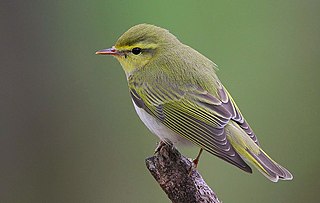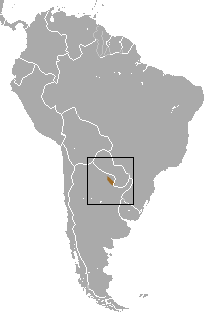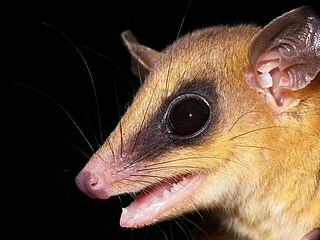Anteater-like
1 genus–(monotypic)
(2 subspecies)
| Anteater-like marsupials | ||||
|---|---|---|---|---|
| Taxa | Presence | Notes | Images | |
Marsupial:
| Western Australia (2 subspecies) |  | ||
This is a list of adaptive radiated marsupials by form; they are adaptively radiated marsupial species equivalent to the many niche-types of non-marsupial mammals. Many of the surviving species are from Australia. There are unique types, for example the extinct genus Nototherium , a 'rhinoceros-type'. [1]
The new world has the common opossum, also a unique form. [2]
Even before the mid-19th century and Charles Darwin's time, biogeographers understood speciation and animal niches. A supreme example that became known to Darwin as sailing ships traveled the world is the New Zealand flightless, ground-dwelling, worm-eating kiwi, a bird, but a species in a mammal-niche.
1 genus–(monotypic)
(2 subspecies)
| Anteater-like marsupials | ||||
|---|---|---|---|---|
| Taxa | Presence | Notes | Images | |
Marsupial:
| Western Australia (2 subspecies) |  | ||
1 genus–(6 species)
| Cat-like marsupials | ||||
|---|---|---|---|---|
| Taxa | Presence | Notes | Images | |
Marsupial:
| Australia & Papua and New Guineas |  | ||
6 genera
2 surviving genera
| Groundhog-like marsupials | ||||
|---|---|---|---|---|
| Taxa | Presence | Notes | Images | |
Marsupial:
|  | |||
1 genus–(2 species)
| Mole-like marsupials | ||||
|---|---|---|---|---|
| Taxa | Presence | Notes | Images | |
Marsupial:
|  | |||
1 genus
| Rhinoceros-like marsupials | ||||
|---|---|---|---|---|
| Taxa | Presence | Notes | Images | |
Marsupial:
| Extinct |  | ||
6 genera
| Panther-like marsupials | ||||
|---|---|---|---|---|
| Taxa | Presence | Notes | Images | |
Marsupial:
| Extinct |  | ||
1 genus–(6 species)
| Flying Squirrel-like marsupials | ||||
|---|---|---|---|---|
| Taxa | Presence | Notes | Images | |
Marsupial:
|  | |||
1 genus–(1 species)
| canine-like marsupials | ||||
|---|---|---|---|---|
| Taxa | Presence | Notes | Images | |
Marsupial:
| Extinct |  | ||
1 genus–(1 species)
| Hyena-like marsupials | ||||
|---|---|---|---|---|
| Taxa | Presence | Notes | Images | |
Marsupial:
| Extirpated from mainland (Tasmania only) |  | ||
? species
| Unique— Opossum-like marsupials | ||||
|---|---|---|---|---|
| Taxa | Presence | Notes | Images | |
Marsupial:
|  | |||

In evolutionary biology, adaptive radiation is a process in which organisms diversify rapidly from an ancestral species into a multitude of new forms, particularly when a change in the environment makes new resources available, alters biotic interactions or opens new environmental niches. Starting with a single ancestor, this process results in the speciation and phenotypic adaptation of an array of species exhibiting different morphological and physiological traits. The prototypical example of adaptive radiation is finch speciation on the Galapagos, but examples are known from around the world.

Marsupials are a diverse group of mammals belonging to the infraclass Marsupialia. They are primarily found in Australasia, Wallacea, and the Americas. One of the defining features of marsupials is their unique reproductive strategy, where the young are born in a relatively undeveloped state and then nurtured within a pouch.

Moles are small mammals adapted to a subterranean lifestyle. They have cylindrical bodies, velvety fur, very small, inconspicuous eyes and ears, reduced hindlimbs, and short, powerful forelimbs with large paws adapted for digging.

Placental mammals are one of the three extant subdivisions of the class Mammalia, the other two being Monotremata and Marsupialia. Placentalia contains the vast majority of extant mammals, which are partly distinguished from monotremes and marsupials in that the fetus is carried in the uterus of its mother to a relatively late stage of development. The name is something of a misnomer considering that marsupials also nourish their fetuses via a placenta, though for a relatively briefer period, giving birth to less developed young which are then nurtured for a period inside the mother's pouch. Placentalia represents the only living group within Eutheria, which contains all mammals more closely related to placentals than to marsupials.

Various Passeriformes are commonly referred to as warblers. They are not necessarily closely related to one another, but share some characteristics, such as being fairly small, vocal, and insectivorous.

The Wallace line or Wallace's line is a faunal boundary line drawn in 1859 by the British naturalist Alfred Russel Wallace and named by the English biologist T.H. Huxley that separates the biogeographical realms of Asia and 'Wallacea', a transitional zone between Asia and Australia also called the Malay Archipelago and the Indo-Australian Archipelago. To the west of the line are found organisms related to Asiatic species; to the east, a mixture of species of Asian and Australian origins is present. Wallace noticed this clear division in both land mammals and birds during his travels through the East Indies in the 19th century.

The family Caenolestidae contains the seven surviving species of shrew opossum: small, shrew-like marsupials that are confined to the Andes mountains of South America. The order is thought to have diverged from the ancestral marsupial line very early. They were once included in the superorder but it is now known that Ameridelphia is paraphyletic, having given rise to Australidelphia, and thus could be considered an evolutionary grade. Genetic studies indicate that they are the second most basal order of marsupials, after the didelphimorphs. As recently as 20 million years ago, at least seven genera were in South America. Today, just three genera remain. They live in inaccessible forest and grassland regions of the High Andes.

Didelphodon is a genus of stagodont metatherians from the Late Cretaceous of North America.

The Old World rats and mice, part of the subfamily Murinae in the family Muridae, comprise at least 519 species. Members of this subfamily are called murines. In terms of species richness, this subfamily is larger than all mammal families except the Cricetidae and Muridae, and is larger than all mammal orders except the bats and the remainder of the rodents.

The Chacoan pygmy opossum is a recently described genus and species of didelphimorph marsupial. The only species in Chacodelphys, C. formosa, was known until 2004 from only one specimen collected in 1920 in the Chaco of Formosa Province, Argentina. The species is gaining popularity as a pocket pet.

The 27 species in the genus Marmosa are relatively small Neotropical members of the family Didelphidae. This genus is one of three that are known as mouse opossums. The others are Thylamys and Tlacuatzin, the grayish mouse opossum. Members of the genus Marmosops used to be called "slender mouse opossums", but are now just called "slender opossums". The thirteen members of the Marmosa subgenus Micoureus, known as woolly mouse opossums, were formerly considered to be a separate genus, but were moved into Marmosa in 2009. Based on a comparison of sequences of one mitochondrial and three nuclear genes, three new subgenera, Eomarmosa, Exulomarmosa and Stegomarmosa, were recognized by Voss et al. in 2014. Eomarmosa and Exulomarmosa, as well as Marmosa and Micoureus, are thought to be sister taxa, while Stegomarmosa is viewed as sister to Marmosa plus Micoureus. Exulomarmosa is a mostly trans-Andean clade.

Ningaui is a genus of small species of the marsupial dasyurid family. Along with the planigales, they are among the smallest marsupials.

Cimolestes is a genus of early eutherians with a full complement of teeth adapted for eating insects and other small animals. Paleontologists have disagreed on its relationship to other mammals, in part because quite different animals were assigned to the genus, making Cimolestes a grade taxon of animals with similar features rather than a genus of closely related ones. Fossils have been found in North America, South America, Europe and Africa. Cimolestes first appeared during the Late Cretaceous of North America. According to some paleontologists, Cimolestes died out at the start of the Paleocene, while others report the genus from the early Eocene.

Caluromyinae is a subfamily of opossums. It includes the extant genera Caluromys and Caluromysiops, as well as the extinct Pachybiotherium. Until recently, the genus Glironia was also included. It has sometimes been classed as a full family, Caluromyidae.

Why Evolution is True is a popular science book by American biologist Jerry Coyne. It was published in 2009, dubbed "Darwin Year" as it marked the bicentennial of Charles Darwin and the hundred and fiftieth anniversary of the publication of his On the Origin of Species By Means of Natural Selection. Coyne examines the evidence for evolution, some of which was known to Darwin (biogeography) and some of which has emerged in recent years. The book was a New York Times bestseller, and reviewers praised the logic of Coyne's arguments and the clarity of his prose. It was reprinted as part of the Oxford Landmark Science series.

Thylacosmilidae is an extinct family of metatherian predators, related to the modern marsupials, which lived in South America between the Miocene and Pliocene epochs. Like other South American mammalian predators that lived prior to the Great American Biotic Interchange, these animals belonged to the order Sparassodonta, which occupied the ecological niche of many eutherian mammals of the order Carnivora from other continents. The family's most notable feature are the elongated, laterally flattened fangs, which is a remarkable evolutionary convergence with other saber-toothed mammals like Barbourofelis and Smilodon.
Groeberiidae is a family of strange non-placental mammals from the Eocene and Oligocene epochs of Patagonia, Argentina and Chile, South America. Originally classified as paucituberculate marsupials, they were suggested to be late representatives of the allothere clade Gondwanatheria. However, the relationship of the type genus, Groeberia, to Gondwanatheria has been firmly rejected by other scholars.

Prosotherium is an extinct genus of hegetotheriid notoungulate. It lived during the Late Oligocene, and its fossilized remains were found in South America.

Amphiperatherium is an extinct genus of metatherian mammal, closely related to marsupials. It ranged from the Early Eocene to the Middle Miocene in Europe. It is the most recent metatherian known from the continent.